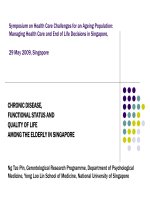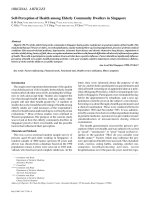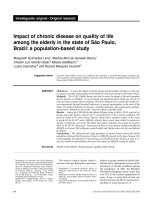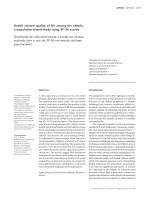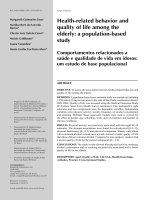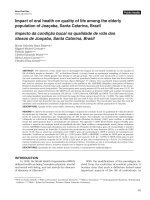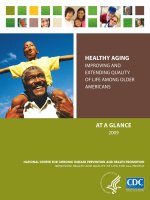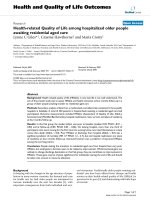Implications of Edentulism on Quality of Life among Elderly pot
Bạn đang xem bản rút gọn của tài liệu. Xem và tải ngay bản đầy đủ của tài liệu tại đây (260.14 KB, 10 trang )
Int. J. Environ. Res. Public Health 2012, 9, 100-109; doi:10.3390/ijerph9010100
International Journal of
Environmental Research and
Public Health
ISSN 1660-4601
Article
Implications of Edentulism on Quality of Life among Elderly
Suely Maria Rodrigues
1
, Ana Cristina Oliveira
1,
*, Andréa Maria Duarte Vargas
1
,
Allyson Nogueira Moreira
2
and Efigênia Ferreira e Ferreira
1
1
Department of Community and Preventive Dentistry, Universidade Federal de Minas Gerais,
Av. Antônio Carlos, 6627, Zip Code 31270.901, Belo Horizonte, MG, Brazil;
E-Mails: (S.M.R.); (A.M.D.V.);
(E.F.F.)
2
Department of Operative Dentistry, Universidade Federal de Minas Gerais, Av. Antônio Carlos,
6627, Zip Code 31270.901, Belo Horizonte, MG, Brazil; E-Mail:
* Author to whom correspondence should be addressed; E-Mail: ;
Tel.: +55-31-3409-2449.
Received: 19 October 2011; in revised form: 3 December 2011 / Accepted: 15 December 2011 /
Published: 4 January 2012
Abstract: This study aimed was to test the association between quality of life and
edentulism among elderly individuals in a city in southeastern Brazil. This cross-sectional
study was carried out with 163 individuals aged 60 years or older, functionally independent
and non-institutionalized. Data were collected with a questionnaire and oral examination.
The edentulism was the dependent variable. The independent variables were sex, age,
household income and quality of life (WHOQOL-Old) and their scores. To assess the
association between the dependent variable and independent variables was used bivariate
analysis (p < 0.10). Poisson regression model was performed, adjusting for age and sex.
The average age of participants was 69 years (± 6.1), 68.7% were female and 52.8% were
diagnosed as completely edentulous (90% CI: 0.33–1.24). When the independent variables
were associated to the prevalence of edentulism, statistically significant associations were
found for age (p = 0.03) and social participation dimension of the WHOQOL-Old
(p = 0.08). In the Poisson regression, social participation remained statistically associated
to edentulism {RP = 2.12 [90% CI (1.10–4.00)]}. The social participation proved to have a
significant association to edentulism, thereby attesting to the negative effect of this condition
on social aspects.
OPEN ACCESS
Int. J. Environ. Res. Public Health 2012, 9
101
Keywords: aged; health of the elderly; oral health; quality of life; dentistry; dental care
for aged
1. Introduction
The ageing of the population in recent decades is a common phenomenon in both developed and
developing countries. This demographic transition is occurring as a result of changes in health
indicators, such as a reduction in birth and mortalities rates and a longer life expectancy [1]. It is
estimated that there will be approximately 34 million elderly individuals in Brazil by the year 2025,
which will be the sixth largest population of elderly individuals in the World. Among the current
population of approximately 170 million inhabitants, the elderly population in Brazil has surpassed
15 million individuals, corresponding to approximately 8% of the total population (6% between 60 and
74 years and 2% aged 75 years or older) [2].
The elderly population in Brazil faces considerable inequality. A large portion of these individuals
have low buying power, a low degree of schooling, difficulties in access to cultural assets and healthcare
and have experienced a loss or inversion of social roles. Thus, this population is more exposed to
factors that compromise quality of life [3]. The investigation into aspects that allow a satisfactory
quality of life among elderly individuals is of scientific and social importance. Studies of this type seek
to establish associations between wellbeing and ageing, thereby contributing toward the understanding
of ageing and the limits of human development [4].
The study of the elderly population has led to new understandings regarding the concept of quality
of life, including physical/psychological/social wellbeing and self-esteem, which can be negatively
affected when health is compromised. It is believed that compromised oral health can affect nutritional
status, physical and mental wellbeing, pleasure in participating in an active social life and, consequently,
quality of life [5].
In 1999, the World Health Organization (WHO) drafted the World Health Organization Quality of
Life-Old (WHOQOL-Old) project specifically to measure quality of life in the elderly population. The
aim of this project was to draft and test a generic quality of life measure for international/cross-cultural
use. This tool allows assessing the impact of social and healthcare services on the quality of life of
elderly individuals as well as a clearer understanding of areas of investment for achieving better gains
in quality of life [6]. The aim of the present study was to test the association between quality of life
and edentulism among elderly individuals in a medium-size city in Brazil.
2. Methods
2.1. Study Design and Population
A cross-sectional study was conducted in a medium-size city in southeastern Brazil. The sample
was made up of male and female individuals aged 60 years or older, functionally independent,
non-institutionalized, clientele of the public healthcare system. The city has 261,261 inhabitants,
21,428 of whom are elderly, representing 8.3% of the total population [7]. The city is divided into
Int. J. Environ. Res. Public Health 2012, 9
102
19 urban administrative districts and has 48 Basic Healthcare Units (BHUs), 35 of which participate in
the Family Health Program. A BHU is a public health clinic that provides ambulatory care for the
population. Twenty-two BHUs offer ambulatory dental care carried out by oral health teams. Only two
districts do not have BHUs and residents in these districts are sent to the closest healthcare unit. The
total number of elderly individuals registered at the BHUs is 13,659, which corresponds to 63.7% of
the total number of elderly individuals in the city.
The calculation of the sample size was based on proportion estimates, considering a 95% confidence
level, 5% accuracy and 90% expected standard as well as the M component of the Decayed, Missing
and Filled Teeth (DMFT) index on the last local epidemiological survey [8,9]. The mean of index was
24.1 (±6.0). The results of the calculation after the final correction for n based on the total number of
elderly individuals registered in the local public healthcare system indicated a minimal sample of
163 individuals, including the 10% added to compensate for possible losses.
In order to ensure the participation of individuals from all geographical districts of the city, a
proportionality calculation was performed using the total number of elderly individuals registered at
each BHU. Only individuals with adequate systemic and physical conditions and the capacity to
answer the questionnaire were included in the study. These conditions were assessed by the occurrence
of systemic diseases, which were identified from medical charts in the archives of the BHUs and with
the assistance of the BHU staff members (physician, nurse, health agent). The participants were
selected randomly by lots among the elderly individuals present in the BHUs each day.
2.2. Data Collection
The socio demographic data considered in the present study were sex, age and family household
income. Household income was measured in terms of the Brazilian minimum wage, a standard for this
type of assessment, which nearly corresponded to 315 US dollars during the period of data collection.
The WHOQOL-Old questionnaire was used to measure quality of life, which was validated for use in
Brazil by Fleck et al. (2006) [10]. The questionnaire has 24 questions grouped into six dimensions
(Table 1). Each question has five Likert response options (1 to 5 points). The total score ranges from
24 to 120 points, for which higher scores denote a better quality of life.
Table 1. Description of dimensions on the WHOQOL-Old.
Dimensions Content Questions
Functioning of senses
Impact of loss of functioning of senses on quality of life
01, 02, 10, 20
Autonomy
Independence; capability of being free to live with
autonomy and make one’s own decisions
12, 13, 15, 19
Past, present and future activities
Satisfaction with life achievements and goals to be reached
03, 04, 05, 11
Social participation
Participation in activities of daily living, especially in the
community
14, 16, 17, 18
Death and dying
Worries and fear regarding death and dying
06, 07, 08, 09
Intimacy Being capable of intimate and personal relationships 21, 22, 23, 24
Source: The WHOQOL-Old Group (2005) [6].
The WHOQOL-Old was administered in interview form, considering the characteristics that are
common to elderly individuals, such as difficulties in reading (visual impairment and illiteracy),
Int. J. Environ. Res. Public Health 2012, 9
103
understanding and marking the response. The oral examination was conducted by the researcher SMR,
with the help of a trained scorer. The tests were conducted under natural light, using a wooden
spatula [11]. A pilot study was carried out with eight elderly individuals receiving dental care at the
teaching institution. The aim of the pilot study was to determine the adequacy of the work method, the
reaction of participants, the way the questions were addressed and time spent. The participants in this
phase were not involved in the main study. The study received approval from the ethics committee of
the Universidade Federal de Minas Gerais (COEP-UFMG 446/07). All participants signed terms of
informed consent.
2.3. Data Analysis
Data analysis was performed using Statistical Package for Social Sciences (SPSS for Windows,
version 16.0, SPSS Inc, Chicago, IL, USA). The frequency distribution was calculated first, followed
by the chi-square test (p < 0.10) to determine associations between the dependent and independent
variables (bivariate analysis). Poisson regression analysis was employed to determine the impact of
each independent variable. The independent variables were included into the multivariable model in
decreasing order based on their statistical significance (p < 0.25/backward stepwise procedure) or for
questions of clinical-epidemiological importance [12]. The model was adjusted for age, sex and
household income. Edentulism (presence/absence) was the dependent variable. The independent
variables were sex, age, household income, total WHOQOL-Old score and score on each dimension of
the questionnaire.
3. Results
One hundred sixty-three elderly individuals participated in the study. All elderly invited to the study
agreed to participate. Age ranged from 60 to 87 years, with a mean age of 69 years (±6.1). The majority
of participants were women (68.7%). Eighty-six individuals were edentulous (52.8%). Just 21 elderly
individuals (12.9%) reported household income of 2.0 to 6.2 times the Brazilian minimum wage
per month.
Table 2 displays the distribution of scores on the dimensions of the WHOQOL-Old questionnaire
associated to the presence or absence of edentulism. There were similar scores between groups,
indicating that edentulism did not affect quality of life. The mean total WHOQOL-Old score was 81.0
[67.0% of maximal score on the index (120 points)], ranging 62 (51.0% of maximal score) to 98
(81.0% of maximal score). Modal and mean values confirmed a quality of life index of around 68.0%
of the maximal score, with no association to edentulism.
When the independent variables were associated to the prevalence of edentulism,
statistically significant associations were found for age (p = 0.03) and social participation (p = 0.08)
(Table 3). Data analysis showed no statistically significant association between age and social
participation (p = 0.74).
Int. J. Environ. Res. Public Health 2012, 9
104
Table 2. Distribution of scores on the WHOQOL-Old dimensions according to presence or
absence of edentulism among elderly individuals (n = 163).
WHOQOl-old dimension Mean Min. 25 percentile Median 75 percentile Max. Modal
Functioning of senses
Edentulous
12.1 ± 3.0
6.0
9.0
12.0
15.0
19.0
9.0
Non-edentulous
11.9 ± 3.1
7.0
9.0
12.0
15.0
20.0
16.0
Autonomy
Edentulous
14.1 ± 1.6
9.0
13.0
14.0
15.0
17.0
15.0
Non-edentulous
14.1 ± 1.6
9.0
13.0
14.0
16.0
17.0
14.0
Present/past/future activities
Edentulous
12.9 ± 1.8
9.0
12.0
13.0
14.0
18.0
14.0
Non-edentulous
13.1 ± 1.8
8.0
12.0
13.0
15.0
18.0
13.0
Social Participation
Edentulous
14.8 ± 1.6
10.0
14.0
15.0
16.0
19.0
16.0
Non-edentulous
14.3 ± 1.8
8.0
13.0
15.0
16.0
19.0
15.0
Death and dying
Edentulous
14.9 ± 3.7
8.0
12.0
16.0
17.7
20.0
16.0
Non-edentulous
14.8 ± 3.8
8.0
12.0
16.0
17.0
20.0
16.0
Intimacy
Edentulous
12.2 ± 2.5
8.0
12.0
12.0
12.0
16.0
12.0
Non-edentulous
12.0 ± 2.4
7.0
12.0
12.0
12.0
16.0
12.0
Total score
Edentulous
81.0 ± 8.1
62.0
75.0
81.5
88.2
98.0
89.0
Non-edentulous 80.4 ± 7.6 62.0 74.0 81.0 84.5 98.0 83.0
Table 3. Distribution of independent variations in relation to prevalence of edentulism
among elderly individuals (n = 163).
Independent variables
Edentulism
Presence (%) Absent (%) Total (100%) p-value *
Unadjusted prevalence
ratio [CI]
Sex
Male
23 (45.1)
28 (54.9)
51
0.18
0.63 [0.33–1.24]
Female
63 (56.3)
49 (43.8)
112
Age (years)
60–68
38 (44.7)
47 (55.3)
85
0.03 0.50 [0.27–0.94]
69–87
48 (61.5)
30 (38.5)
78
Household income
<2BMW
75 (52.8)
67 (47.2)
142
0.97
1.01 [0.65–1.56]
≥2BMW
11 (52.4)
10 (47.6)
21
Functioning senses
6–12
46 (50.5)
45 (49.5)
91
0.52
0.81 [0.44–1.52]
13–20
40 (55.6)
32 (44.4)
72
Autonomy
9–14
47 (50.0)
47 (50)
94
0.41
0.76 [0.41–1.43]
15–17
39 (56.5)
30 (43.5)
69
Int. J. Environ. Res. Public Health 2012, 9
105
Table 3. Cont.
Independent variables
Edentulism
Presence (%) Absent (%) Total (100%) p-value *
Unadjusted prevalence
ratio [CI]
Present/past/future activities
8–13 45 (52.3) 41 (47.7) 86 0.90 0.96 [0.52–1.78]
14–18 41 (53.2) 36 (46.8) 77
Social Participation
8–15 37 (61.7) 23 (38.3) 60
0.08
1.78 [0.93–3.44]
16–19 49 (47.6) 54 (52.4) 103
Death and dying
8–16 64 (52.9) 57 (47.1) 121 0.95 1.02 [0.50–2.06]
17–20 22 (52.4) 20 (47.6) 42
Intimacy
7–12 67 (52.8) 60 (47.2) 127 0.99 0.99 [0.47–2.09]
13–16 19 (52.8) 17 (47.2) 36
Total score
62–81 43 (52.4) 39 (47.6) 82
0.93
0.97 [0.52–1.80]
82–98 43 (53.1) 38 (46.9) 81
* 10% level of significance; ** BMW: Brazilian minimum wage.
Table 4 displays the results of the Poisson regression. Unlike the other variables analyzed in the
model, social participation remained statistically associated to edentulism. Individuals with social
participation values between 8 and 15 had a twofold greater chance of pertaining to the edentulous
group {RP = 2.12 [90% CI (1.10–4.00)]}.
Table 4. Poisson regression model explaining the presence of edentulism in
elderly individuals.
Backward stepwise model **
Variable Ratio
Adjusted PR*
[CI]
Social participation
8–15
16–19
2.12 [1.10–4.00]
1
* PR: prevalence ratio/10% level of significance; ** Adjusted for age, sex and household income.
4. Discussion
Edentulism was encountered in 52.8% of the participants. This finding may stem from socioeconomic
factors, little or no information on oral healthcare, access and type of dental services used throughout
life. Mutilating dental treatment (extraction) indicates that oral healthcare measures were either
inexistent or failed wholly, reflecting decades of dentistry centered on non-conservative curative
procedures. Brazilian studies demonstrate that the epidemiological situation of the elderly population
in relation to edentulism is a serious problem [13-16]. The elderly form a group with nearly all their
teeth extracted. This problem tends to worsen when no healthcare measures are taken aimed at offering
dental care to the entire population, especially adults. Knowledge on the influence of edentulism over
the quality of life of elderly individuals is important and should be produced and shared by the entire
Int. J. Environ. Res. Public Health 2012, 9
106
healthcare team, as good health does not exist without good oral health. All individuals should have
adequate oral health that allows them to speak, chew, recognize flavors, smile, live without pain or
discomfort and interrelate with others without embarrassment [17,18].
Although the present study may be considered consistent, it has some limitations that should be
addressed. The weakness of cross-sectional studies resides in the difficulty establishing causal relations
based on a cross-section in time. Moreover, it is likely that the sample may have excluded important
data from individuals not included in the study, despite the randomization. Although adapted to the
Portuguese language and validated in Brazil, the WHOQOL-Old questionnaire has a number of
questions that are difficult to understand, which poses an obstacle to choosing the most adequate
response regarding what one has experienced or felt within a specific time period. This was observed
during the interviews with the elderly individuals, who often asked for the question to be repeated.
The presence and absence of edentulism were quite homogeneous with regard to the dimensions of
the WHOQOL-Old questionnaire. These data demonstrate that the tooth loss was seen as a consequence
of ageing among the individuals surveyed and appears to have little or no impact on their quality of
life. However, although it was not the objective of the present study, one point should be stressed: the
participants only achieved 67.0% of the total possible score on the WHOQOL-Old questionnaire,
which implies a 33.0% loss in quality of life.
The investigation into the quality of life of elderly individuals has received growing interest in the
healthcare field. With the increase in this population, there is also an increase in the need to understand
the life context of these individuals in order to provide them with a better health status through
interventions capable of having a positive impact on the process of healthy ageing.
Due to its characteristic of decentralized care, the BHU is the first contact of the population with the
public healthcare system and the present study was conducted in BHUs due to the frequent presence of
elderly individuals in these locations. The BHU is a public place where the population receives
ambulatory care. The functioning of these health units allows the continuous follow up of patients by
multidisciplinary healthcare teams, with an integrated vision of the individual and emphasis on disease
prevention.
The greater participation of women during the data collection is likely related to greater care
women take regarding health problems and consequent greater use of medical/dental services. According
to Trentini et al. [19], despite have a greater need for care, men demonstrate greater acceptance of the
ageing process and related health problems. Women demonstrate greater flexibility and dynamism
with regard to ageing, always seeking possible remedies for daily health demands. The greater number
of women may also be associated to the “feminization of ageing” phenomenon, as women account for
the majority of the elderly population worldwide and have a greater life expectancy; on average,
women live eight years longer than men [2].
The bivariate analysis revealed a significant association between edentulism and age. This result
was expected, considering the progressiveness of dental caries, which account for most cases of tooth
loss. Indeed, the Brazilian National Oral Health Survey reports a progressive DMFT index in the
Brazilian population, considering the ages of 12 years (2.7 ± 3.12), 15 years (6.17 ± 4.82), 35 to
44 years (20.13 ± 7.74) and 65 to 74 years (27.79 ± 6.71) [13]. The DMFT index means number of
teeth decayed, missing and filled [11]. It is fundamental in both clinical practice and research for oral
health-related quality of life assessment tools to be more widely used. Such tools allow important
Int. J. Environ. Res. Public Health 2012, 9
107
outcomes for the lives of elderly individuals to be taken into account in both biological and social
terms when formulating public health policies. The use of such tools could result in changes in
healthcare practices and the consolidation of new paradigms in the health-disease process, with
important promotion, prevention, treatment and rehabilitation actions in the healthcare field.
Rehabilitation is an alternative, but should not be considered a solution. Healthcare, therefore, should
have a broader scope and not be restricted to this age group, but should be a continuous effort
involving younger generations and accompanying the entire lifecycle.
Analyzing the dimensions of the WHOQOL-Old, social participation was statistically associated to
the prevalence of edentulism in both the bivariate and multivariate analyses. A greater percentage of
respondents with a Social Participation score between 8 and 15 points were diagnosed as edentulous.
For this population, social participation is an important factor in the perception of a better quality of
life. Inadequate oral health, such as missing teeth, may have a negative influence over social activities,
leading individuals to isolate themselves from others. According to Avlund et al. [20], regardless of
age, social needs persist throughout the entire lifecycle. The majority of elderly individuals seek to
maintain and broaden their social relations though group movements, leisure activities and non-formal
education in an effort to promote wellbeing.
With the ageing process, social relations undergo changes, which can play an essential role in
maintaining or even improving physical and mental health. Intensive, pleasurable social experiences
provided by social participation allow the formation and maintenance of friendships, which can assist
in facing crises and conflict and also have an influence over self-awareness, self-esteem, personal
change, learning and satisfaction with life. The positive effects of social participation are associated to
the usefulness of different types of support (emotional and functional). With social support, elderly
individuals generally feel loved, are confident when dealing with health problems and have higher
self-esteem [21].
A study carried out in Brazil involving edentulous individuals found an improvement in self-image
and self-esteem following the incorporation of removable complete dentures. The reports stressed
the recovery of esthetics as the gateway for returning to social activities, which indicates the
suffering caused by missing teeth. The patients felt “complete” again, but still considered themselves
impaired [22].
The performance of activities of daily living may strengthen feelings of self-worth. According to
the WHO (2002) [1], autonomy “is the ability of control, deal with and make personal decisions about
how one should live on a daily basis in accordance with one’s own rules and preferences”, which is
fundamental to the wellbeing of elderly individuals. As individuals age, their quality of life is strongly
determined by their ability to maintain autonomy and independence. An adequate functional state is
essential to maintaining physical and psychological wellbeing; as such activities require the interaction
of cognitive resources, emotional aspects and motor skills. Physical dependence is an obstacle to
general health and oral health. Individuals with a high degree of physical and/or functional dependence
have a poorer oral health status.
Social participation can have a positive effect on quality of life among elderly individuals, for it
provides a social support system that contributes toward minimizing feelings of loneliness and
abandonment. The activities carried out appear to be an important factor, as they reinforce feeling of
self-worth while also enabling personal growth [23]. Tooth loss can affect an individual’s ability to
Int. J. Environ. Res. Public Health 2012, 9
108
interrelate with others and can have a considerable impact on his/her lifestyle due to problems
with communication in family and social interactions, causing depression, sadness, loneliness and
isolation [24,25].
5. Conclusions
The prevalence of edentulism among the elderly individuals surveyed in the present study is similar
to that found in the Brazilian population. Edentulism was expected to have negative consequences
regarding quality of life, but did not prove to be a determinant for this outcome in this group. The
social participation dimension of the WHOQOL-Old proved to have a significant association to
edentulism, thereby attesting to the negative effect of this condition on social aspects. The overall
WHOQOL-Old score demonstrated a 40.0% loss in quality of life in this group, indicating the need for
more in-depth studies on this issue.
References
1. World Health Organization (WHO). Active Ageing: A Policy Framework; WHO: Geneva,
Switzerland, 2002.
2. Síntese de Indicadores, 2008. Instituto Brasileiro de Geografia e Estatística (IBGE) Web site.
Available online: (accessed on 12 August 2009).
3. Lima-Costa, M.F.; Barreto, S.M.; Giatti, L. Health status, physical functioning, health services
utilization, and expenditures on medicines among Brazilian elderly: A descriptive study using
data from the National Household Survey. Cad. Saude Coletiva 2003, 19, 735-743.
4. Fleck, M.P.; Chachamovich, E.; Trentini, C.M. WHOQOL-old project: Method and focus group
results in Brazil. Rev. Saude Publica 2003, 37, 793-799.
5. Hugo, F.N.; Hilgert, J.B.; Souza, M.L.; Silva, D.D.; Pucca, G.A., Jr. Correlate of parcial tooth loss
and edentulism in Brasilian elderly. Community Dent. Oral Epidemiol. 2007, 35, 224-232.
6. WHOQOL-OLD Group. Development of the WHOQOL-old module. Qual. Life Res. 2005, 14,
2197-2204.
7. Departamento de Informática do SUS, 2010. Ministério da Saúde, Brasil, DATASUS Web site.
Available online: (accessed on 12 March 2007).
8. Levy, P.S.; Lemeshow, S. Sampling of Populations: Methods and Applications;
Wiley-Interscience: New York, NY, USA, 1991.
9. Governador Valadares. Prefeitura Municipal de Governador Valadares. Secretaria Municipal de
Saúde (SMS); Departamento de Atenção Básica, Levantamento Epidemiológico: Governador
Valadares, Brasil, 2006.
10. Fleck, M.; Chachamovich, E.; Trentini, C. Development and validation of the Portuguese version
of WHOQOL-Old. Rev. Saude Publica 2006, 40, 785-791.
11. World Health Organization. Oral Health Surveys: Basic Methods; WHO: Geneva,
Switzerland, 1997.
12. Austin, P.C.; Tu, J.V. Automated variable selection methods for logistic regression produced
unstable models predicting acute myocardial infarction mortality. J. Clin. Epidemiol. 2004, 57,
1138-1146.
Int. J. Environ. Res. Public Health 2012, 9
109
13. Projeto SB Brasil 2003: Condições de Saúde Bucal da População Brasileira 2002–2003:
Resultados Principais; Ministério da Saúde: Brasília, Brazil, 2004.
14. Hebling, E.; Pereira, A.C. Oral health-related quality of life: A critical appraisal of assessment
tools used in elderly people. Gerodontology 2007, 24, 151-161.
15. Hilgert, J.B.; Hugo, F.N.; Sousa, M.L.; Bozzetti, M.C. Oral status and its association with obesity
in Southern Brazilian older people. Gerodontology 2009, 26, 46-52.
16. Silva, D.D.; Rihs, L.B.; Sousa, M.L. Factors associated with remaining teeth of elderly in the state
of São Paulo, Brazil, 2002. Gerodontology 2009, 26, 1-9.
17. Patil, M.S.; Patil, S.B. Geriatric patient-psychological and emotional considerations during dental
treatment. Gerodontology 2009, 26, 72-77.
18. Nunes, C.I.; Abegg, C. Factors associated with oral health perception in older Brasilians.
Gerodontology 2008, 25, 42-48.
19. Trentini, C.M.; Chachamovich, E.; Costa, M.; Muller, M.; Fleck, M. Impact variables associated
with quality of life in old adults research. Qual. Life Res. 2003, 12, 1763-1770.
20. Avlund, K.; Holm-Pedersen, P.; Morse, D.E.; Viitanen, M.; Bengt, W. Social relations as
determinants of oral health among persons over the age of 80 years. Commun. Dent. Oral
Epidemiol. 2003, 31, 454-462.
21. Del Pino, A.C. Calidad de vida em la atención al mayor. Rev. Mult. Gerontol. 2003, 13, 188-192.
22. Silva, M.E.; Magalhães, C.S.; Ferreira, E.F. Complete removable prostheses: From expectation to
(dis)satisfaction. Gerodontology 2009, 26, 143-149.
23. Velarde-Jurado, E.; Avila-Figueroa, C. Evaluación de la calidad de vida. Salud Pública Méx.
2002, 44, 349-361.
24. Srisilapanan, P.; Sheiham, A. The prevalence of dental impacts on daily performances in older
people in Northern Thailand. Gerodontology 2001, 18, 102-108.
25. Heinonen, H.; Aro, A.R.; Aalto, A.M.; Uutele, A. Is the evaluation of the global quality of life
determined by emotional status? Qual. Life Res. 2004, 13, 1347-1356.
© 2012 by the authors; licensee MDPI, Basel, Switzerland. This article is an open access article
distributed under the terms and conditions of the Creative Commons Attribution license
(
